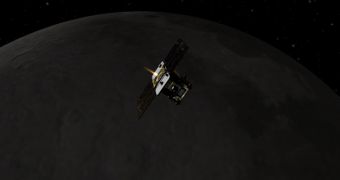Both GRAIL spacecraft are now in lunar orbit, officials from the American space agency announced. The two probes managed to achieve orbital insertion in time, on December 31, 2011 and January 1, 2012, respectively.
The purpose of the Gravity Recovery And Interior Laboratory (GRAIL) is to create the most detailed map of the gravity pull of the Moon over its entire surface. Things such as underground hollows or accumulations of heavy chemicals can modify gravity nearly imperceptibly.
GRAIL-A and GRAIL-B will fly in a precise formation, always checking their distance from each other. When they start passing over an area displaying gravitational anomalies, the distance between them shifts by a small margin, which the sensitive instruments onboard can detect.
As they fly over the entire Moon, Earth's natural satellite will reveal all of its areas of interest to GRAIL. Mission controllers will then have to translate the speed difference data into information about how the lunar subsoil looks like.
The two spacecraft were set on their path to the Moon about three months ago. Usually, a space probe takes about three days to complete the journey, but NASA had mission controllers plan an alternate, fuel-saving route.
This is why the probes arrived a day apart. GRAIL-A reached the Moon at 2 pm PST (2200 GMT) on December 31, 2011, while GRAIL-B managed to insert itself in lunar orbit at 2:43 pm PST (2243 GMT) on January 1, 2012.
At this point, the GRAIL science mission is scheduled to begin in March. The spacecraft are now located at an altitude of about 34 miles (55 kilometers) above the lunar surface, in a near-polar, near-circular orbit, NASA reports.
“NASA greets the new year with a new mission of exploration. The twin GRAIL spacecraft will vastly expand our knowledge of our Moon and the evolution of our own planet,” said Charles Bolden, the Administrator of NASA.
“We begin this year reminding people around the world that NASA does big, bold things in order to reach for new heights and reveal the unknown” he explained further.
The GRAIL mission is managed by the Jet Propulsion Laboratory (JPL), in California, for the NASA Science Mission Directorate, in Washington, DC. The JPL is a division of the California Institute of Technology (Caltech), also in Pasadena.

 14 DAY TRIAL //
14 DAY TRIAL //